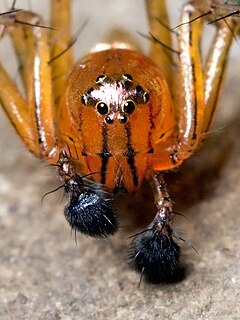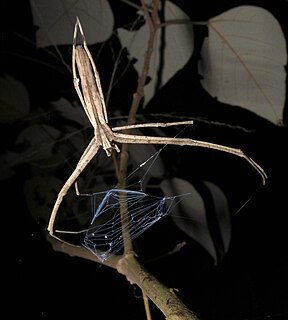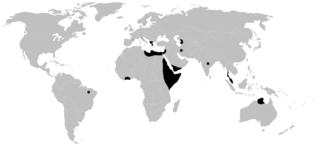
Pedipalps are the second pair of appendages of chelicerates – a group of arthropods including spiders, scorpions, horseshoe crabs, and sea spiders. The pedipalps are lateral to the chelicerae ("jaws") and anterior to the first pair of walking legs.

Deinopidae, also known as net casting spiders, is a family of cribellate spiders first described by Carl Ludwig Koch in 1850. It consists of stick-like elongated spiders that catch prey by stretching a web across their front legs before propelling themselves forward. These unusual webs will stretch two or three times their relaxed size, entangling any prey that touch them. The posterior median eyes have excellent night vision, allowing them to cast nets accurately in low-light conditions. These eyes are larger than the others, and sometimes makes these spiders appear to only have two eyes. Ogre-faced spiders (Deinopis) are the best known genus in this family. The name refers to the perceived physical similarity to the mythological creature of the same name. This genus also includes the humped-back spiders (Menneus).
Lamottella is a spider genus of the jumping spider family, Salticidae. Its single described species, Lamotella longipes, is found in Guinea.

Cithaeronidae is a small family of araneomorph spiders first described by Simon in 1893 Female Cithaeron are about 5 to 7 millimetres long, males about 4 millimetres (0.16 in).

Deinopis subrufa is a species of net-casting spiders. It occurs in Australia and in New Zealand. It is a nocturnal hunter, having excellent eyesight, and hunts using a silken net to capture its prey. They feed on a variety of insects – ants, beetles, crickets and other spiders. They can vary in color from fawn to pinkish brown or chocolate brown. Females are about 25 mm in body length, males about 22 mm. They are not dangerous to humans.

Deinopis, also known as net-casting spiders, gladiator spiders and ogre-faced spiders, is a genus of net-casting spiders that was first described by W. S. MacLeay in 1839. Its distribution is widely tropical and subtropical. They catch their prey using a specially spun "net". The name is derived from the Greek δεινός (deinos), meaning "fearful", and opis, meaning "appearance", referring to their ogre-like faces. The spelling "Dinopis" is also found, but is regarded as an "unjustified emendation".

Guasca is a Colombian town and municipality in the Guavio Province, part of the Cundinamarca Department located approximately 55 km from Bogotá passing through the town of La Calera, Cundinamarca or 65 km passing through Sopó. Guasca borders the municipalities Tocancipá and Guatavita in the north, Junín in the east, in the south La Calera and in the west Sopó.

Spiders are air-breathing arthropods that have eight legs, chelicerae with fangs generally able to inject venom, and spinnerets that extrude silk. They are the largest order of arachnids and rank seventh in total species diversity among all orders of organisms. Spiders are found worldwide on every continent except for Antarctica, and have become established in nearly every habitat with the exceptions of air and sea colonization. As of July 2019, at least 48,200 spider species, and 120 families have been recorded by taxonomists. However, there has been dissension within the scientific community as to how all these families should be classified, as evidenced by the over 20 different classifications that have been proposed since 1900.
Agelena longipes is a species of spider in the family Agelenidae, which contains 1146 species of funnel-web spiders. It was first described by Carpenter, 1900. It is primarily found in England.
Amaurobius longipes is a species of spider in the family Amaurobiidae, found in Greece.

Phrynus longipes is a species of amblypygid often found in the Caribbean. They are also found in other warm climate areas such as the forests of Central America. Within this region, however, Phrynus longipes lives in an array of habitats from caves to coastlines. They are protective of their territory, using their pedipalps to deter predators or unwanted visitors. Being nocturnal predators, they take shelter during the day and hunt primarily at night. Phrynus longipes feed on both vertabrates and invertebrates. They are the first amblypygid to be recorded feeding on an avian species.

Holothele is a genus of tarantulas that was first described by Ferdinand Anton Franz Karsch in 1879. Originally placed with the curtain-web spiders, it was transferred to the tarantulas in 1980.
Lycinus is a genus of spider in the family Nemesiidae, found in parts of South America.

Syspira is a genus of spiders in the family Miturgidae. It was first described in 1895 by Simon. As of 2017, it contains 6 species found in the U.S. and/or Mexico.
Mainosa is a genus of spiders in the family Lycosidae. It was first described in 2006 by Framenau. As of 2017, it contains only one species, Mainosa longipes, found in Australia.

Deinopis spinosa, known generally as the ogrefaced spider or net-casting spider, is a species of ogrefaced spider in the family Deinopidae. It is found in the United States, St. Vincent, and Venezuela. This spider is notable for its use of a net to catch prey. It does this by holding a small web stretched across its legs while it is suspended from a sparse web frame. When prey approaches the spider, it lunges forward and captures the insect in its net. In order to capture prey flying above it the spider uses a backward striking motion. When prey is outside its field of vision this spider appears to use a sensory organ located on its front legs to sense to prey. This sensory organ is known as the metatarsal organ. During the day, the spider is immobile and camouflages itself on its host palm plant. At night, the spider hunts.
Micaria longipes is a species of ground spider in the family Gnaphosidae. It is found in North America.

Scytodes longipes is a species of spitting spider in the family Scytodidae. It is found in Southern America, has been introduced into Pacific Islands, Guinea, Congo, Indonesia, and Australia (Queensland).
Allende is a genus of South American long-jawed orb-weavers that was first described by F. Álvarez-Padilla in 2007.











